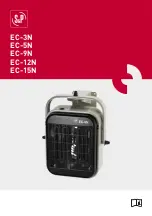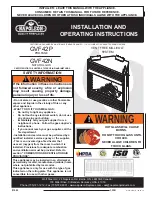
HearthStone Quality Home Heating Products, Inc.
LUNO 8160 Gas-Fired Direct-
Vent
turned to “ON”, the main burner should light immediately. If
you would like to use the thermostat and it is installed,
switch the ON/OFF/Remote switch to thermostat. Turn the
remote transmitter to "ON" and set it to a higher position so
that it "calls" for heat in order to light the main burner (i.e.
turns the unit on). Note that the remote thermostat controls
the on/off cycling of the main burner, but the pilot remains
lit regardless of the remote thermostat setting. The only
way to turn the pilot off is to turn the gas control knob fully
clockwise to the “OFF” position.
T
O
T
URN
O
FF
G
AS
T
O
A
PPLIANCE
1. Set the Remote thermostat to the “OFF” position or
turn the ON/OFF/REMOTE switch to the “OFF”
position.
2. If shutting the unit off for the non-heating season, turn
the gas control knob fully clockwise to the “OFF”
position. Do not force the knob to turn.
A
IR
S
HUTTER
The air shutter is used to regulate the air-to-gas
combustion mixture, which in turn influences the size and
color of the flames. The air shutter is factory set in the
general location needed for Natural Gas (NG), however, if
the unit is not burning as well as it should, then the air
shutter may need adjusting. The air shutter may need
adjustment once the unit has been installed to compensate
for variations in supply line pressure, restriction plate
position, altitude, fuel gas type conversions, and other
variables.
To determine if the air shutter needs adjustment, it is
necessary to view the flame pattern with the variable output
control knob at its highest setting. Allow the unit to operate
for at least 10 minutes to allow the
entire unit to reach
temperature, and for the flame pattern to stabilize.
Generally, the more air (open shutter) in the mixture, the
bluer the flame. Less air (closed shutter) results in a more
yellow flame, but too little air will result in incomplete
combustion, low efficiency and a dirty burn. There are two
simple guidelines to aid in determining the correct flame
pattern:
If the flame at the base of the logs is completely blue,
the air shutter is possibly open too far;
If the flame is dirty (sooty) or licks the top of the stove,
the air shutter is possibly closed too far.
Some conditions cannot be corrected through air shutter
adjustment; an adjustment must be made to the gas supply
pressure or by changing the restriction plate location.
Qualified service personnel must perform supply
line/manifold gas line pressure adjustments and restrictor
plate adjustments. Do not attempt to complete any part of
the installation or adjustment of this unit unless technically
qualified to do so.
A
IR
S
HUTTER
A
DJUSTMENTS
The air shutter adjuster, located under the valve access
door, at the lower front of the unit, is adjustable while the
stove is burning. Under the burner assembly, but above the
valve is the air shutter handle. It is a steel handle bent
down for you to grasp. It uses a thumbscrew to lock the
position of the shutter in place.
This handle and screw
will get very hot during operation
. Loosen the
thumbscrew and slide the shutter back and forth a couple
of times to understand the “throw” of the shutter. Push the
handle forward to close the air shutter. Pull it towards you
to open the air to the unit. When the flame pattern is
correct, tighten the locking nut without turning the screw.
The air shutter is factory set and only a qualified gas
technician should make adjustments.
Note:
Very little movement is needed to substantially
change the burn and flame patterns. Some conditions
cannot be corrected through air shutter adjustment; an
adjustment must be made to the gas supply pressure.
Supply line/manifold gas line pressure adjustments must be
performed by qualified service personnel. Do not attempt
to complete any part of the installation or adjustment of this
unit unless technically qualified to do so.
P
ILOT
A
DJUSTMENT
The pilot light is preset by the manufacturer and should not
need adjustment. However, you should perform a periodic
visual check of the pilot flame. The pilot light flame should
be large enough to engulf the thermopile and thermocouple
located next to the pilot, but not so large as to create
excessive noise or consume excessive gas
(Refer to figure
10)
. If needed, the pilot flame is adjustable by means of the
pilot light adjustment screw located on the gas control valve
(see figure 8)
. Open the valve door to access the pilot
adjustment screw. Note that the pilot flame must engulf the
thermopile so that the thermopile can generate sufficient
milli-voltage (325 to 500-mv) to power the gas control
valve. The flame on the pilot should look like
Figure 10
.
Controlling the Luno by the remote or wall-mounted
thermostat may become erratic, nonexistent, or the unit
may go out, if the pilot flame is too small or misdirected
away from the thermopile.
IGNITER
THERMOCOUPLE
PILOT
FLAME
THERMOPILE
PILOT CLIP
Figure 11: Pilot flame and assembly
17












































